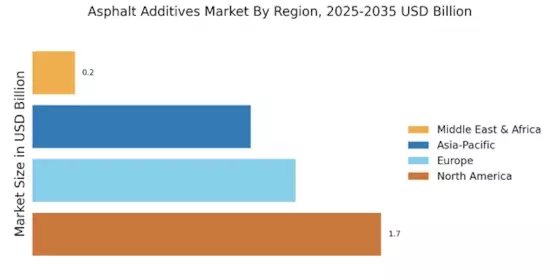Growing Awareness of Road Safety
The Asphalt Additives Market is increasingly influenced by the growing awareness of road safety among governments and the public. As traffic volumes rise, the need for safer road surfaces becomes paramount. This awareness is prompting stakeholders to invest in high-performance asphalt that incorporates additives designed to improve skid resistance and reduce accidents. The market is witnessing a shift towards products that not only meet durability standards but also enhance safety features. Additionally, the integration of smart technologies in road construction is gaining traction, further emphasizing the importance of safety in asphalt applications. Consequently, manufacturers are focusing on developing innovative additives that can contribute to safer road conditions, thereby aligning their offerings with the evolving priorities of the industry.
Rising Demand for Durable Pavements
The Asphalt Additives Market is experiencing a notable increase in demand for durable pavements. This trend is largely driven by the need for longer-lasting road surfaces that can withstand heavy traffic and adverse weather conditions. As urbanization continues to expand, the pressure on infrastructure increases, necessitating the use of high-performance asphalt. According to recent data, the market for asphalt additives is projected to grow at a compound annual growth rate of approximately 5.2% over the next few years. This growth is indicative of a broader shift towards materials that enhance the longevity and resilience of pavements, thereby reducing maintenance costs and improving safety. Consequently, manufacturers are focusing on developing innovative additives that can enhance the performance characteristics of asphalt, making it more appealing to contractors and government agencies alike.
Environmental Regulations and Standards
The Asphalt Additives Market is significantly influenced by stringent environmental regulations and standards. Governments worldwide are increasingly implementing policies aimed at reducing the environmental impact of construction materials, including asphalt. These regulations often encourage the use of recycled materials and eco-friendly additives, which can enhance the sustainability of asphalt products. For instance, the incorporation of warm mix asphalt technologies has gained traction, as it reduces emissions during production and application. The market is expected to see a shift towards additives that comply with these regulations, potentially leading to a rise in the adoption of sustainable practices within the industry. As a result, companies that prioritize environmentally friendly solutions may gain a competitive edge, aligning their products with regulatory requirements and consumer preferences.
Increased Investment in Infrastructure Projects
The Asphalt Additives Market is benefiting from increased investment in infrastructure projects across various regions. Governments and private entities are allocating substantial budgets for the development and maintenance of transportation networks, including roads, highways, and airports. This surge in infrastructure spending is expected to drive demand for asphalt additives, as high-quality materials are essential for constructing durable and safe road surfaces. Recent reports indicate that infrastructure investment is projected to reach trillions of dollars over the next decade, creating a favorable environment for the asphalt additives market. As a result, manufacturers are likely to see heightened demand for their products, particularly those that enhance the performance and longevity of asphalt mixtures.
Technological Innovations in Asphalt Production
Technological advancements are playing a crucial role in shaping the Asphalt Additives Market. Innovations in production techniques and material formulations are enabling the development of superior asphalt products that offer enhanced performance. For example, the introduction of polymer-modified asphalt has revolutionized the industry by improving elasticity and resistance to deformation. Furthermore, advancements in testing and quality control technologies ensure that additives meet stringent performance criteria. The market is witnessing a surge in research and development activities aimed at creating additives that can improve the durability and sustainability of asphalt. This focus on innovation is likely to drive market growth, as stakeholders seek to leverage new technologies to enhance the quality of asphalt mixtures and meet evolving consumer demands.


















Leave a Comment